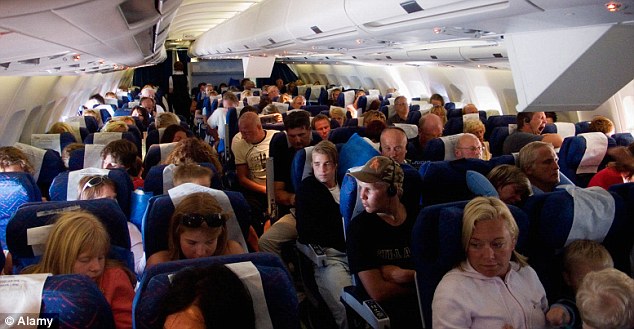We Give An Inch; They Want Two.
In addition to airplanes, Airbus, the big European consortium, is now into balloons … trial balloons, that is. They recently floated one that has stirred up a hornet’s nest, albeit so far a small one.
Airbus wonders what we all might think of their idea to increase the number of seats in each row on their wide-body planes from the current ten seats in a 3-4-3 configuration to eleven seats. That of course, would mean increasing the center section to five seats–a three-five-three arrangement.

A simple question: When is this going to stop? A realistic answer: When government finally steps in.
The real question is what will it take to make that happen. Worst case scenario? Well, we all know what that would be. The best case scenario would be for a cool, rational, sensible person at the FAA to conclude that several hundred people crammed into rows of eleven narrow seats with absolutely minimal legroom cannot possibly evacuate an aircraft within the 90 seconds or whatever amount of time the agency has set as the limit. That’s when the government steps in and says, “Enough!” And they set minimum standards: so many inches wide and so many inches of leg room. Minimum. That’s it. Period. If you want your planes to fly in U.S. air space.
And that’s all it takes.


Although embracing the concept of a free market, the more I have become involved as an advocate for passenger rail, the more I realize the term “free market” is the most abused term in non-rail transportation since “I’ll love you in the morning.” Notice how the pharmaceutical industry has staked its right on the free market to charge prices on whatever the market will bear for its monopoly products…
We can argue about the economic merits of de-regulating the airlines in 1978, especially when these private carriers still rely on the trough of the Essential Air Services subsidy at $300 Million per year. However, safety, health, and welfare cannot be sacrificed for economics (i.e., “profits”). The time is now for the FAA (another federal subsidy), to step-up and announce explicit regulations governing the number of seats, as well as the type of seats for lumbar, neck, head comfort. U.S. carriers need not look to replicate the mass seating of domestic flights in Japan, China, and Saudi Arabia.
In addition to the obvious safety factor of not being able to escape from an incident within the given time, what about the increased delay to access toilets? Perhaps the FAA should identify a ratio of seats to toilets? If this corporate insanity is not abated, we are going to find in short order passengers suffering from serious orthopedic, kidney, and GI issues; a serious incident will clearly evidence the airlines motto of “greed is dependable.”
On the note of “greed,” why does the same Congress that bellyaches about Amtrak’s minimal annual subsidy say nothing as the ancillary profits grow every year (currently $6+ Billion) for the airlines charging for preferred seats, baggage, etc? Where is the federal, state, local, and airport tax on these charges to lower the cost of subsidizing the airports, FAA, and airline operations?
This is a grossly over-subsidized, fiscally questionable industry trying to squeeze more revenue out of their investment. The worse and more uncomfortable air-travel becomes the better for every more rational and more cost-effective solution – like, say, inter-city passenger rail.
Air travel is only financially viable for long haul flights; let the short hop and commuter routes die off, replaced by surface transportation options – which will also lead to more equitable access and investment for intermediary communities which cannot afford to subsidize an airport.
As our country fails to teach history in detail, many people fail to note how the private railroads provided a superb network of regional intercity rail corridors, linking towns en route with major cities via fast, frequent, high service trains. Operating under steam/diesel in the famous Midwest corridors, many of these trains ran over 100+ mph on jointed rail with numerous grade crossings.
What killed this network of intercity corridor trains was not the unions or management, but rather, overt, direct federal subsidization to the private airlines facilitating their move into the short haul markets, post WWII. The Feds created an un-level playing field preventing the railroads from competing. For example, the railroads continued to pay tax to every local/state/federal jurisdiction on their depots, yards, and right-of-way, as compared to the airlines having the Feds build and maintain their infrastructure, including air traffic control for safety.
Seeking higher profits, the airlines today, after merging into three legacy carriers, are significantly reducing frequency or simply abandoning many short haul markets. As the buses no longer maintain their network of local routes, these small towns seeking mobility and economic development will be totally dependent upon an inter-city rail corridor approach to their market. This economic marketplace reality cannot be lost as the media continues to erroneously promote stories just focusing on the elderly, disabled, and college students dependence upon rail.